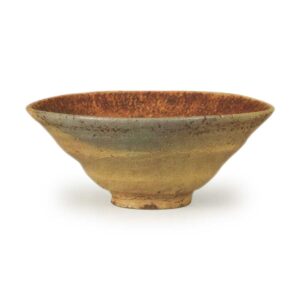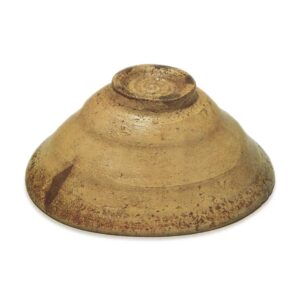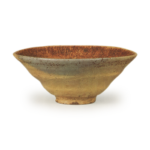

Height: 6.7 to 7.1 cm
Diameter: 16.7 to 17.0 cm
Outer diameter of foot: 5.5 cm
Height of foot: 0.7 to 1.0 cm
This is a famous bowl for soba noodles, along with the moon. The ground of the bowl is a light yellow color, but in one place it changes to a light blue-gray, and this scenery is the most attractive thing about this bowl.
The name “Tamagawa” was given by Fumai, who likened the scene to the reflection of a golden-yellow flower in water, and took the meaning of the old poem by Shunsei, “The golden-yellow flower’s dew still trickles down the well’s Tamagawa”, and named it Tamagawa.
The base is a sticky clay with white sand, and a thin, transparent glaze is applied to the entire inside and outside. The firing is slightly oxidized, and due to the small amount of iron contained in the clay, both the inside and outside are a loquat color, but the rim is reduced by flame for about one third of the way around, turning it a blue-gray color. The shape is a wide-mouthed, shallow, flat bowl, supported by a low, tight foot ring. There is a spiral pattern on the underside of the bowl, and the center is slightly raised. There are five eyes on the foot ring. The construction is thinner than that of a well, and there are three thick potter’s wheel marks on the body, although the top two are not so clear, the bottom two are particularly strong and thick, and are one of the highlights of this tea bowl. The waist is plump and full, and on the other side, which has turned a light blue-grey, there is a part called “himma” where the glaze does not cover the rim. The hima that is often seen in kohiki is a white coating on the base material that has become dirty, but in this case the base material itself has become dark brown from stains such as tea stains.
The inside is a light yellowish-brown, but the part that has turned blue-gray on the outside has also turned a light blue-gray on the inside, and the inside has a dimple and six eyes around it. It is a beautiful tea bowl with few flaws, with only a single thin vertical groove around the rim.
It was owned by the former Matsudaira Fumai, then by Tōkansai Kaku Kyū, and in the early Taishō period it was acquired by Maekoshi Kōhei, who passed it on to Nozaki Kōta. After the war, it was in the Nagao Museum for a long time, but it is now owned by Ōfuku Jirō. I have also heard a rumor that Keita Goto, who lived by the Tamagawa River, was very keen to acquire this tea bowl.
The box is made of paulownia wood and lacquered with a black lacquer, and on the front of the lid, silver powder has been used to write the name of Lord Matsudaira Fumai, and on the upper right, “Tamagawa”, and on the lower left, “Chawan”, and on the back of the lid, an old poem by Shunsei is written.








